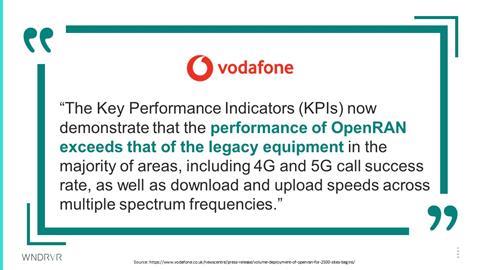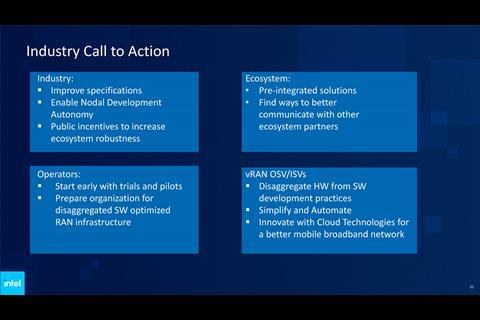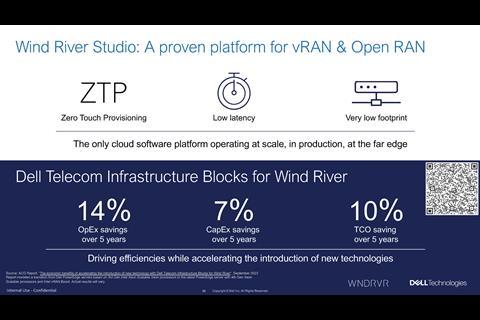- Drawing on multiple commercial deployments of open and virtualised radio access networks incorporating its cloud platform, Wind River is on a mission to spread the word that Open RAN is ready for prime time, delivering on financial and operational promise.
- Presenting at the Fyuz23 event in Madrid with two of its key collaborators, Intel and Dell, the systems provider’s Open RAN “Tipping Point” workshop gives operators an insiders’ roadmap for a proven collaborative approach to transition from disaggregation to reaggregation, including the clear accountability critical for successful deployment.
- Deployments at Verizon and Vodafone are showcased as operational and commercial outriders, with the wider operator ecosystem urged to leverage early adopter experience and develop a clear strategy for their own transformation journeys.
- Wind River also emphasises that its scalable cloud solutions provide a unique foundation for innovation at the network edge, with openness and interoperability underpinning flexibility and speed for operators.

Wind River made the Telecom Infra Project’s Fyuz23 conference in Madrid the first public stop for its new Open RAN operator workshop format that taps frontline experience to unwrap how the intelligent systems software provider, working alongside key partners, has created a scalable cloud ecosystem.
The Tipping Point workshop showcases Open RAN technology as demonstrably successful not just in theoretical conditions, but also operationally and as a viable element of operators’ commercial strategy.

With live Open and virtualised RAN deployments across multiple regions already meeting a range of network needs, Wind River not only makes claims, it brings the actuals.
Davide Cherubini, Wind River’s Senior Specialist Solutions Architect, underlined that the systems provider’s case for Open RAN and vRAN has moved far beyond the hypothetical. This is not ‘in the lab’ or ‘proof of concept’, he stressed, this is real commercial deployments.
The confidence of the vendor is built on multiple pillars:
- Strong partnerships.
- Hardware that is catching up to virtualisation’s requirements.
- Field experience that has informed strategy development.
- And, critically, the strength of a cloud platform developed with a focus on Open RAN that can also be applied to a wide range of use cases that go beyond access networks.
The Tipping Point workshop included partner contributions from Dell (which is pioneering commercialisation of software-driven access technology in a solution optimised to operator requirements) and Intel (a core technology innovator also uniquely positioned to see how the promise of Open RAN can be fulfilled).
The trio emphasised that the wider growing Open RAN community also plays important parts in building the momentum for software-driven access networks. These include established tech giants such as Samsung, which is another key Wind River partner (most recently at O2 Telefónica in Germany) and cloud-centric specialists such as Mavenir and Parallel Wireless. Collaboration, cooperation and shared experience are viewed by all as essential for Open RAN to succeed.
From Wind River’s engagements, Open RAN has been shown to have now reached its tipping point. Cherubini considers that, with live commercial proof and the strength of collaboration relationships cultivated across the industry, the vendor is perfectly positioned to partner operators for the final push.
Cherubini and his co-presenters also take the Tipping Point workshop on the road to operators worldwide. The Fyuz23 preview incorporated input from these roadshows, including providing detail and engineering insight into how an open approach can support network evolution for operators at scale, and help achieve key business and sustainability targets.
Wind River sees benefits of scalability stacking up
Wind River’s own open access network proposition is built on three elements of its cloud platform:
- As the only commercialised incarnation of the open StarlingX platform, the vendor is enabling cloud for the network edge with its Wind River Studio Cloud Platform. Cherubini stressed that not only is the platform now commercially deployed, it is also well established and has had time to reach maturity, having first been architected in 2017.
- Studio Conductor plays a key role in ensuring the openness of virtualised access environments. Described as an end-to-end automation platform, Studio Conductor can be used to orchestrate public and private clouds, including distributed Wind River clouds, subclouds, and competing clouds.
- Studio Analytics, meanwhile, is intended to bring AI and machine learning-driven capabilities to support full stack monitoring — aggregating and analysing data across distributed clouds supporting the closed loop automation enabled by Conductor. This, according to Cherubini, is helping to bring the scalability that is a key benefit of an effective cloud platform for access networks.
Collectively integrated with partner hardware (such as Dell’s), the Wind River suite can be certified and managed throughout the network lifecycle and enable multiple choices of RAN software from vendors including Ericsson, JMA Wireless, Mavenir, Nokia, and Samsung, among others.
Dell — completing the disaggregation puzzle to win the prize
A critical element of moving Open RAN from the test bed to the commercial front line has been ensuring two expectations can be met:
- Delivery of a core turnkey solution that just works.
- Clear vendor accountability.
With Wind River’s engagements, these prerequisites are achieved through close collaboration with a sizeable group of notable ecosystem partners, which include its Tipping Point workshop companions.
Dell contributed to the workshop through insights provided by Mohammed Elsayed, its Principal Telecom Architect for Cloud, Automation & Intelligent Network in EMEA.

The technology solutions provider gave the compelling example of how it has reaggregated the disparate elements of an open solution in order to address the fundamental challenge of creating a disaggregated software-driven solution that can then be managed and leveraged by operators as a viable working solution.
As described by Elsayed, this reaggregation has been solidified through Dell’s Telecom Infrastructure Blocks. These encompass extensive testing, validation, and integration efforts, resulting in an engineered Infrastructure Block solution tailored for Wind River and the xRAN use case.
This solution comprises Dell PowerEdge servers powered by 4th Gen Intel Xeon Scalable processors and Dell Bare Metal Orchestrator, with Bare Metal Orchestrator Modules designed to seamlessly integrate with Wind River Studio Conductor. These components are constructed into an xRAN cloud-platform solution that is backed by a “carrier-grade unified support” experience. The offering includes service level commitments that are on par with more conventional technology deployments as well as single-call accountability, simplified procurement, and well-defined account management processes.
Dell’s commitment to expedited deployment is evident through the shipment of pre-integrated solutions from Wind River.
According to Elsayed, this deployment journey commences with customer lab testing of the engineered and integrated solution, ensuring a rapid “day one” implementation process. Automation also plays an increasingly significant role in streamlining deployment, complemented by ongoing coordinated lifecycle management practices.
Adding to this rigour, Wind River’s Cherubini outlined how the systems player has established a “validation factory” approach to ensuring fast and sustainable deployment, with feedback loops at every stage of the process. This starts with an emphasis on hardware pre-integration, progresses to internal lab testing, and goes on to testing with specific equipment providers, prior to entering the customer lab and ongoing assessment in the live commercial environment.
Ongoing validation also provides proactive and predictive detection of failures and associated recommendations.
Across five years, operating expenditure savings were projected at 14% and capital expenditure savings at 7%, significantly lowering total cost of ownership. The research estimated that, for delivering a full foundational multicloud environment that could cost $2bn+ for a tier-one operator, savings of over $200m could be achieved compared to deploying non-integrated solutions.
Intel — silicon breakthroughs see cloud platforms “like a freight train coming”

Matt Conrod, Director of Global Business Development at Intel, said his enthusiasm for the role of cloud platforms in telecoms was sparked quickly after joining the microelectronics major in 2018.
A veteran of the telco sector, having switched from Ericsson, he said that within weeks he had recognised that the levels of innovation around both cloud and silicon made the case for disaggregating hardware and software for telecoms clear – “This is like a freight train coming at the industry: we must bring containerised cloud services to telecom”.
Backing his personal belief, Conrod highlighted the advances Intel has made in tailoring processors to the requirements of software-based RAN deployments, claiming that 4th Gen Intel Xeon Scalable processors with Intel vRAN Boost have delivered a doubling of capacity alongside a 20% improvement in energy cost efficiency. He also noted that Intel Ethernet adapters have been developed to work specifically in a highly virtualised environment, including enhancements in timing, resiliency and high availability.
Conrod was also frank in acknowledging that there have been reservations privately expressed within operators that ran counter to the enthusiasm surrounding network virtualisation. However, he considers that these have been addressed with the latest generation of silicon and its virtualisation-targeted enhancements. Most notable, concern that potential capital expenditure savings could be somewhat reversed by the risk of higher operational costs has been alleviated. Instead, substantial gains are now being seen on key aspects of access delivery, including unlocking the benefits of choice on both hardware and software in key elements of the network, automation savings on mobile broadband delivery, and lower energy demands.
Case study: Verizon’s virtual wizardry now a reality
Verizon has implemented what is currently considered the largest vRAN deployment in the world, supported by Wind River. Deployed alongside the Red Hat OpenStack Platform, Wind River Studio is facilitating a distributed hybrid cloud architecture with cloud native 5G infrastructure. The operator is said to be already around halfway towards a 2026 target of 60,000 far edge node deployments that are facilitated by its work with Wind River and built on the foundations of the Verizon Cloud Platform and its 5G core.

Wind River’s Cherubini highlighted Verizon as demonstrating the benefits of having key elements of the Wind River Cloud Platform integrated with hardware when deployed at the network edge. With so many sites at the edge, keeping the network working optimally can place a strain on the transport component when data needs to be moved between the edge and central data centres, which could create problems should the transport network experience any instability. The pre-integrated Wind River solutions adopted by Verizon reduces the levels of data that need to transit between locations from gigabytes to megabytes, thus ensuring access network quality remains high, operating at pace with fewer errors.
Intel’s Conrod commenced his segment by suggesting that Wind River and Cherubini had perhaps been “a bit bashful” when describing achievements. He reframed this as Wind River “setting the pace” for OS vendors in deploying vRAN at scale by drawing on experience gained in the past three years working in the field, particularly in bringing Verizon’s vRAN and Massive MIMO deployments to major cities such as New York.
Wind River — cloud is scaling telcos to new vistas: choosing the right route…
Wind River’s Cherubini stresses the importance of operators selecting a cloud platform that can support the performance and cost efficiency benefits of Open RAN, including handling demanding edge use cases in settings ranging from dense urban to remote rural deployment. This also provides opportunity to gain first-user advantage as new services enabled by an open environment are deployed more quickly.
Scalability is also critical to Wind River when positioning its Open RAN offering, with Cherubini highlighting that Studio can extend from a single node to multiple deployments covering network elements from the far edge to the national data centre.
In practice, this could see a single server at the far edge, or a more complex far edge supporting redundancy and high availability — with accompanying controller, storage and worker node clusters at regional data centres, and national data centres in a distributed cloud.
An important element in ensuring that the open platform can capture the benefits of flexibility and distributed cloud capabilities is recognising the different demands on elements of the network, both in terms of location and pattern of demand.
The edge cloud has markedly different demands compared to a data centre, with limited space, often no air conditioning, and challenging climactic conditions. This, Cherubini considers, is when the benefits of a low intensity infrastructure are most felt, with a single server in an existing facility capable of delivering services as part of a distributed cloud.
The solutions provider asserts that automation enables faster deployment, as well as lower operating expenditure, and minimising human error that is prevalent in manual operations. “It is really the game changer for vRAN and Open RAN”, says Cherubini.
Intel’s Conrod agreed on the significance of automation, highlighting the rapid progress Verizon was able to achieve with its vRAN rollout as more processes were automated, working in conjunction with Wind River .“It’s easy to get this [vRAN] to work”, he notes, but “It’s more difficult to train your people and create processes and tools to do this at scale”.
Shrinking the infra footprint for a significant sustainability benefit
Sustainability gains are now essential criteria for network development, and Wind River was keen to emphasise that virtualised RAN solutions can be a positive contributor towards operator goals.
Its Open RAN solutions enable network delivery with a smaller infrastructure footprint, and offer lower power consumption, particularly when allied to more efficient and economical use of physical assets.
A not insignificant advantage to the provider’s open solutions was described by Cherubini as the ability to re‑use existing infrastructure at sites, which will have economic and environmental upside for telcos. He noted that much of the equipment on existing sites can be re‑adopted for virtualised access deployments. This includes transmission, power, tower, and civil works, creating considerable efficiency opportunities.
Operators have choice on integration… and a call to make
Operators play the central role in ensuring that cloud platform deployments used for open access make the most of the potential flexibility without getting bogged down in the complexity that accompanies open choices, according to Wind River’s Cherubini.
Accordingly, it is crucial for operators to have a clear vision of their own role in delivering open access networks, and the degree of responsibility they will manage internally in areas such as system integration.
The use of tightly integrated solutions such as the Dell Telecom Infrastructure Blocks (and from other hardware and systems players in the Open RAN and vRAN ecosystem) can minimise the need for complex systems integration on deployments.
Vodafone was highlighted as an operator that had a defined strategic goal of managing systems integration oversight, which has paid off as it starts to expand its Open RAN footprint. In the US, Verizon has similarly taken a lead in ensuring its virtualised RAN fits within its infrastructure and supports its strategic goals.
This approach need not be restrictive in terms of future disaggregation choices, in Cherubini’s view. The Wind River platform remains open to supporting continued disaggregation due to its compatibility with a range of container technologies that can be used to facilitate wider choice.
Case study: Vodafone leading breakthroughs for European market
Vodafone Group is ramping up its commitment to Open RAN, with the operator aiming for 30% of mobile sites in Europe to be providing access using the technology by 2030. Wind River’s Cherubini noted that the goal is even more ambitious in the UK, home of early Golden Cluster deployments leveraging Wind River technology and where the government has set expectations that all operators must ensure 35% of network traffic is delivered through Open RAN sites.

Wind River is providing Containers-as-a-Service (CaaS) capabilities to Vodafone UK using Wind River Studio, which is partnered with radio units from vendors NEC and Samsung alongside hardware from Intel and Dell. Deployed in regional centres and at the edge, Wind River is at the heart of Vodafone UK’s commercial rollout, which began in May 2023.
Vodafone has noted that Open RAN deployments already outperform traditional solutions on most Key Performance Indicators (KPIs), including call success rate, and download and upload speeds across multiple spectrum bands.
Trailblazers ready to share experience as sector urged to follow their lead
When it comes to taking the early steps into Open RAN deployment, the Tipping Point workshop partners recommend that operators draw on the experience of early implementations as a template.
Wind River highlights that with the financial headroom created by lower cost, quicker rollout networks can translate into accelerated innovation, with opportunities to gain first-mover advantage through new solutions that take advantage of these capabilities to achieve faster time to market.
It adds that while being first on RAN transformation has clear merits, being a close second can also reap rewards, particularly now that the technology has been tempered in live deployments.
Existing live Open RAN installations, as implemented with a close ring of partners including Dell, Intel, NEC, Samsung and Wind River, provide an experiential and architectural starting point that can be assimilated and implemented quickly, with reduced risk.
Once up and running, the opportunity to switch out software and solutions reflecting the priorities and strategy of the operators can be undertaken in a controlled, measurable manner, with the open interfaces inherent in the initial solutions capable of facilitating ongoing change.
As the presence of vRAN and Open RAN deployments spreads across markets, it is expected that learnings available will similarly expand, with service providers taking the opportunity to leverage this experience.
This was echoed elsewhere at Fyuz23, with Vodafone emphasising the importance of cooperation and shared experience as an Open RAN accelerator. Francisco (Paco) Martín Pignatelli, the operator’s Head of Open RAN, suggested that the leaders in the field among the world’s largest telcos have “both the responsibility and the opportunity to support the smaller ones in getting on the Open RAN journey”.
Wind River is playing its own part in supporting efforts to break down obstacles on the Open RAN path, including with the Tipping Point workshop format set to tour further industry events and operator campuses to help advance discussions and adoption.
Coordination and cooperation key to effective Open RAN solutions
Sitting between hardware vendors and the expanding universe of RAN and edge solutions providers, Wind River is urging coordination in setting roadmaps and aligning product features. Supporting this objective, it oversees a partner programme intended to ensure the flow of pre‑validated solutions.
The basis for Wind River’s interoperability support can be seen in its contributions to the open development community, including through involvement in the ORAN Alliance and Telecom Infra Project (Fyuz23 host), along with open-source contributions to RAN development that go back to the ‘noughts’. This has helped the vendor establish a position where its CaaS capabilities underpin disaggregated solution stacks in a range of access network environments.
















































